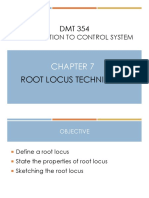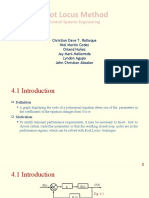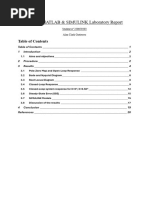Module 2&3
Uploaded by
devin.ezekiel2003Module 2&3
Uploaded by
devin.ezekiel2003Table of Content
CONTROL LABORATORY 2024 1
Module 2 5
Objectives 5
Basic Theory 5
Properties of Root Locus 5
Sketching the Root Locus 7
Root Locus for Discrete Systems 9
Tools 10
Procedures 10
References 10
Module 3 11
Objectives 11
Basic Theory 11
Drawing Bode Plots 12
Drawing the Nyquist Diagram 14
Tools 16
Procedure 16
References 16
Module 2 | Root Locus 3
Table of Figure
CONTROL LABORATORY 2024 1
Module 2 5
Figure 2.1. Closed-Loop System 6
Figure 2.2. Example of root locus and asymptotes of a system 9
Figure 2.3. Diagram showing a discrete root locus with 2 poles and 1 zero 9
Module 3 11
Figure 3.1. Bode Plots, Magnitude Plots (left) and Phase Plots (right) 13
Figure 3.2. Example of a stable Third-Order Nyquist Plot (no encircle in -1) 15
Module 2 | Root Locus 4
Module 2
Root Locus Method
Objectives
1. Understanding the concept and function of Root Locus.
2. Understanding the sketching of Root Locus.
3. Understanding how to analyze the system’s stability using the Root Locus
method.
Basic Theory
Root Locus Technique is a graphical analysis method for system stability. By
using Root Locus Technique, we can analyze how a closed-loop system behaves as
the gain is changed. This closed-loop behavior can be obtained by only observing its
open-loop system. This method could also be used to design a system that meets
the required specification(s) and/or characteristic(s). To analyze a system using
Root Locus Technique, we need to sketch the Root Locus of a system on an s-plane
(frequency domain). Root Locus itself is a path of a closed-loop system’s pole(s)
movements as the gain is changed.
Properties of Root Locus
By observing a control loop system, we’ll obtain the properties of Root Locus.
Figure 2.1 shows a closed-loop system:
Module 2 | Root Locus 5
Figure 2.1. Closed-Loop System
Simplifying the block with mathematical analysis, we’ll obtain the closed-loop
transfer function as:
𝐶(𝑠) 𝐾𝐺(𝑠)
𝑇 (𝑠 ) = 𝑅(𝑠)
= 1+𝐾𝐺(𝑠)𝐻(𝑠)
And the characteristic equation as,
1 + 𝐾 𝐺( 𝑠) 𝐻 (𝑠) = 0
According to eq. 2.2,
𝐾𝐺(𝑠)𝐻(𝑠) =− 1 = 1∠(2𝑘 + 1)180° 𝑘 = 0, ±1, ±2, ±3, …
where -1 is represented in polar form as 1∠(2𝑘 + 1)180°, having a magnitude and an
angle, hence
|𝐾𝐺(𝑠)𝐻(𝑠)| = 1
1
𝐾= |𝐺(𝑠)||𝐻(𝑠)|
∠𝐾𝐺(𝑠)𝐻(𝑠) = (2𝑘 + 1)180° 𝑘 = 0, ±1, ±2, ±3, …
Eq. 2.5 is called the magnitude criterion, whilst eq. 2.6 is called the angle criterion. An
s point on the s-plane needs to satisfy both properties to be a part of a system’s root
locus.
Module 2 | Root Locus 6
Sketching the Root Locus
Please refer to the Material Assistance Sheets and/or video tutorial for better understanding
regarding these parts.
There are 5 basic criterions for drawing the root locus,
1. The quantity of branches: Branches in Root Locus methods represent the
number of closed-loop poles of the system.
2. Symmetry: Root Locus is symmetrical to real axis.
3. Segment in the real axis: in the real axis, for K>0, root locus is placed on the
right side of the poles and/or zeros in the odd-numbered real axis.
4. Starting and finishing point: Root Locus starts from open-loop poles (when
K=0) and finishes at open-loop zeros (when K → ∞) including poles and zeros
at the infinite point.
5. Intersection between real axis and Asymptote: Determine 𝜃 (angle against
the real-axis) and its real-axis intersection point 𝜎 by using equation below:
(2𝑘+1)π
θ𝑎 = #𝑝𝑜𝑙𝑒𝑠−# 𝑧𝑒𝑟𝑜𝑠
𝑘 = 0, ±1, ±2, ±3, …
∑𝑝𝑜𝑙𝑒𝑠−∑𝑧𝑒𝑟𝑜𝑠
σ𝑎 = #𝑝𝑜𝑙𝑒𝑠−#𝑧𝑒𝑟𝑜𝑠
Other than the five criterions described above, there are three additional
criterions that can be used to refine the Root Locus sketch:
1. Break-away and Break-in points: The coordinates at the real axis where the
close-loop poles begin to leave or re-enter the real axis. Those coordinates
can be found using the below equation:
𝑚 𝑛
1 1
∑ 𝑠 + 𝑧𝑖
= ∑ 𝑠 + 𝑝𝑖
1 1
or,
𝑑𝐾 1
𝑑𝑠
= − 𝐺(𝑠)𝐻(𝑠)
Module 2 | Root Locus 7
2. Imaginary-axis crossing (𝑗ω − 𝑎𝑥𝑖𝑠 𝑐𝑟𝑜𝑠𝑠𝑖𝑛𝑔): The coordinates at the
imaginary axis where closed-loop poles leave the negative real axis towards
the positive real-axis and vice versa. This will give the boundaries that will
separate the stable operation of the system from the unstable operation.
3. Angle of departure and arrival: the angle that the root locus make when
departing from open-loop complex poles and arriving at open-loop complex
zeros.
Meanwhile, the procedure to sketch the root locus is:
1. Determine the open-loop transfer function and place the poles and zeros in
the frequency domain
2. Determine the scope of Root Locus for the real axis domain.
3. Determine the amount and the angles of the asymptotes and its intersection
with the real axis as well.
4. Determine the breakaway point and break-in point, by differentiation or
equation below
5. Determine the intersection between Root Locus and imaginary axis (if exist).
6. Determine the Break-in angle (for zeros) and break-away (for poles).
7. Sketching Root Locus using all the data and information acquired.
Module 2 | Root Locus 8
Figure 2.2. Example of root locus and asymptotes of a system
Root Locus for Discrete Systems
While root loci for continuous systems, as we have discussed above, are
drawn in the s domain, root loci for discrete systems are drawn in the z domain. The
characteristic equation is as follows:
1 + 𝐺𝐻(𝑧) = 0
Figure 2.3. Diagram showing a discrete root locus with 2 poles and 1 zero
1. The closed-loop poles in z map must lie within the unit circle for the system to
be stable.
2. If a simple pole lies at z = 1, or a single pair of conjugate complex poles lies
on the unit circle, the system becomes critically stable.
3. Closed-loop zeros do not affect stability and may be placed anywhere in the z
plane.
Module 2 | Root Locus 9
Tools
● Computer
Procedures
1. Open the ‘Laboratory Sheet’ in your EMAS class. For this module, AnyDesk is
not necessary.
2. Answer the questions and upload photos or scans of your workings (if
necessary) according to the instructions.
Python Syntax
In this module, we can use Python as a tool to help our work, especially to plot the
Root Locus plot that we have learnt before. Here are few syntax that we usually use
in this module:
Plotting Root Locus:
Code: (Note that “ct” here is short for control that has been defined and imported
above with the code “import control as ct”)
Module 2 | Root Locus 10
Output:
Root Locus Python Documentation:
https://python-control.readthedocs.io/en/0.9.4/generated/control.root_locus.html
Note that these functions are only the mostly used functions. There are many other
functions or methods that can be used in Python for this field. You can explore the
documentation yourself.
References
Nise, Norman S. Control System Engineering, Chapter 8: Root Locus Technique
Ogata, Katsuhiko. Discrete-Time Control Systems, 2nd edition.
Module 2 | Root Locus 11
Module 3
Frequency Response Method
Keywords: Frequency Response, Magnitude, Phase, Closed-loop Stability, Bode, Nyquist
Objectives
1. To understand the concept of Bode and Nyquist Diagrams.
2. To determine stability through the concept of frequency response.
Basic Theory
In this module, we will be looking into frequency response methods to analyze
and design a control system. The information obtained from the analysis with
frequency response methods differ from the information obtained from the root
locus method, in which both methods complement each other. One of the
advantages of using the frequency response methods is that we can obtain data for
a measurement without having to create a mathematical model of a system.
The frequency response of a system is defined as the steady state response
of a system when it is given a sinusoidal wave input. When a linear-time-invariant
(LTI) system is given an input sinusoidal wave, the output of the system will also be a
sinusoidal wave that differs in amplitude and phase. Although the amplitude and
phase differ by a certain value, the frequencies are the exact same.
For example, if an input sinusoid of 𝑀𝑖 cos 𝑐𝑜𝑠 (ω𝑡 + ϕ𝑖), or 𝑀𝑖(ω)∠ϕ𝑖(ω) in
phasor complex number representation, is given to a system, that system will deliver
an output of 𝑀𝑜 cos 𝑐𝑜𝑠 (ω𝑡 + ϕ𝑜), or 𝑀𝑜(ω)∠ϕ𝑜(ω). Please note that the system
itself is represented in phasor complex number as 𝑀(ω)∠ϕ(ω).
To find the output equation, we must multiply the input equation with the
system equation. The relationship of the input and output is represented with the
following:
𝑀𝑜∠ϕ𝑜 = 𝑀𝑖𝑀∠(ϕ𝑖 + ϕ)
Module 3 | Frequency Response 12
Based on this, we can now determine the function of the system as:
𝑀𝑜(ω)
𝑀(ω) = 𝑀𝑖(ω)
ϕ(ω) = ϕ𝑜(ω) − ϕ𝑖(ω)
𝑀(ω) is the magnitude response of the system and ϕ(ω) is the phase
response of the system. The combination of the two is called the frequency
response in the complete form of 𝑀(ω)∠ϕ(ω). There are two main ways to sketch a
frequency response diagram: the Bode Plot and Nyquist (Polar) Plot.
Drawing Bode Plots
Bode Plots consist of two subplots: the Magnitude and Phase plots. The
Magnitude plot shows the relationship between the magnitude (in logarithmic scale)
with the frequency in the power of tens. The phase plot shows the relationship
between the phase angle with the frequency in the power of tens. If a system has the
transfer function of 𝐺(𝑠), the frequency response can be obtained by substituting the
𝑠 for 𝑗ω. The Asymptotic Approximation of a Bode Plot is drawn by separating all zero
and pole components, then drawing them one by one before drawing the final plot
that is the accumulation of every plot drawn beforehand.
In the following examples in Fig. 3.1, there are two things that need to be
considered, which are the Gain Margin and the Phase Margin. Gain Margin is the
difference between 0 dB and the gain (magnitude) as the phase plot crosses the
angle of 180° or -180°, whilst the Phase Margin is the difference of the angle 180° or
-180° and the phase angle as the magnitude plot crosses 0 dB. The Gain Margin
determines how much gain (magnitude) can be increased before the system
becomes unstable, or how much gain should be decreased to make the system
stable. The Phase Margin works similarly, but instead uses phase angle instead of
gain. Both the Gain Margin and Phase Margin must have values greater than zero (0)
for the closed-loop system to become stable.
Module 3 | Frequency Response 13
Figure 3.1. Bode Plots, Magnitude Plots (left) and Phase Plots (right)
Module 3 | Frequency Response 14
Drawing the Nyquist Diagram
The Nyquist Diagram consists of only one component, a complex plane that
has real values for the x-axis and imaginary values for the y-axis, and a contour plot
(in complex number representation) that moves from the frequency of -∞ to ∞.
A closed-loop system has the following transfer function of
𝐺(𝑠)
𝑇 (𝑠 ) = 1+𝐺(𝑠)𝐻(𝑠)
Where the characteristic equation would be
1 + 𝐺(𝑠)𝐻(𝑠) = 0
The values of s that fulfills the characteristic equation, or the zeroes of that
characteristic equation, can be considered as the poles of the closed-loop system.
In a Nyquist Diagram, the complex representation of frequency response of
𝐺(𝑗ω)𝐻(𝑗ω) can be plotted in a complex plane by inserting the frequency values from
ω = 0 to ω = ∞. To plot the complex function, we would need to decompose it into
real and imaginary values. We can do this by multiplying 𝐺(𝑗ω)𝐻(𝑗ω) with the
complex conjugate of the denominator, resulting in the denominator becoming real
and the imaginary part only existing on the numerator part. Once you get to separate
the Real and Imaginary parts, you can then find the frequency where the Real
component is zero, and the frequency where the Imaginary component is zero. For
the rest of the plot, the values are the Magnitude for a certain frequency 𝑀(ω).
2 2
|𝑀(ω)| = 𝑅𝑒𝑎𝑙 𝐶𝑜𝑚𝑝𝑜𝑛𝑒𝑛𝑡 + 𝐼𝑚𝑎𝑔𝑖𝑛𝑎𝑟𝑦 𝐶𝑜𝑚𝑝𝑜𝑛𝑒𝑛𝑡
The values are plotted into a semicircle shape on the bottom part of the plot,
showing the movement of the magnitude of frequency response from 0 to ∞.
Afterwards, draw a mirrored semicircle shape on the top part of the plot, as to show
the movement of the magnitude of frequency response from -∞ to 0.
The finished Nyquist Plot of a third-order system would look like this:
Module 3 | Frequency Response 15
Figure 3.2. Example of a stable Third-Order Nyquist Plot (no encircle in -1)
Stability in a closed-loop system can be determined by using the Nyquist
Diagram by using the equation:
𝑍=𝑃 −𝑁
With P as the number of open-loop poles of 𝐺(𝑠)𝐻(𝑠) that are located at the
right half of a complex plane. N is the number of anti-clockwise encirclements the
plot gives at value -1. If the plot gives clockwise encirclements, decrement the value
of N. The number of encirclements is determined by the order of your system, the
higher the order, the more encirclements it gives. Z is the number of zeroes from the
characteristic equation we have seen earlier, or the closed-loop poles that are
located at the right half of the plane. If Z is greater than 0, then the closed-loop
system is unstable.
Module 3 | Frequency Response 16
Tools
● Computer
Procedure
1. Open the ‘Laboratory Sheet’ in your EMAS class. For this module, AnyDesk is
not necessary.
2. Answer the questions and upload photos or scans of your workings (if
necessary) according to the instructions.
Python Syntax
In this module, we can use Python as a tool to help our work, especially to plot the
frequency response including the bode plot and Nyquist plot that we have learnt
before. Here are few syntax that we usually use in this module:
Plotting Bode Plot (Exact Bode Plot, not approximate, so there will be some
difference with the theory on how to sketch bode plot approximately)
Code:
Module 3 | Frequency Response 17
Output:
Plotting Bode Plot with Gain Margin and Phase Margin
Code:
Module 3 | Frequency Response 18
Output:
Plotting Nyquist Plot
Code:
Module 3 | Frequency Response 19
Output:
Documentations
Nyquist:
https://python-control.readthedocs.io/en/0.9.4/generated/control.nyquist_plot.html
Module 3 | Frequency Response 20
Bode:
https://python-control.readthedocs.io/en/0.9.4/generated/control.bode_plot.html
Note that these functions are only the mostly used functions. There are many other
functions or methods that can be used in Python for this field. You can explore the
documentation yourself.
References
Nise, Norman S. Control Systems Engineering, 6th edition. U.S.A, John Wiley & Son.
Visioli, Antonio. Fadali, M. Sami. Digital Control Engineering Analysis and Design
Module 3 | Frequency Response 21
You might also like
- Pesetsky Language-Particular Processes and The Earliness PrincipleNo ratings yetPesetsky Language-Particular Processes and The Earliness Principle38 pages
- Linear Control System Lab: Utilizing Simulink To Implement The Mathematical Model of Translational Mechanical SystemNo ratings yetLinear Control System Lab: Utilizing Simulink To Implement The Mathematical Model of Translational Mechanical System8 pages
- Peaps: Heaps Implemented Without ArraysNo ratings yetPeaps: Heaps Implemented Without Arrays12 pages
- Supply and Demand: Economic Analysis of Maggi NoodlesNo ratings yetSupply and Demand: Economic Analysis of Maggi Noodles8 pages
- Control Systems Engineering: Theory and Worked Example: January 2009No ratings yetControl Systems Engineering: Theory and Worked Example: January 200949 pages
- LAB No. 10 Analysis of Linear Control System Using Root Loci TechniqueNo ratings yetLAB No. 10 Analysis of Linear Control System Using Root Loci Technique7 pages
- Pres07 MNG512 (111 - 112) Root Locus AnalysisNo ratings yetPres07 MNG512 (111 - 112) Root Locus Analysis35 pages
- Chap 6 - Root Locus: UEEA 3423 Control SystemsNo ratings yetChap 6 - Root Locus: UEEA 3423 Control Systems46 pages
- 1437235816control Systems (K-Wiki Root Locus) PDFNo ratings yet1437235816control Systems (K-Wiki Root Locus) PDF24 pages
- cours 2-Bases de regulations discretes_v14No ratings yetcours 2-Bases de regulations discretes_v1432 pages
- Root Locus Analysis in Z Plane: Dr. Sadeq Al-Majidi0% (1)Root Locus Analysis in Z Plane: Dr. Sadeq Al-Majidi10 pages
- ELM 322 Control Systems Laboratory: EXPERIMENT 4: Chapter 8, Root-Locus TechniquesNo ratings yetELM 322 Control Systems Laboratory: EXPERIMENT 4: Chapter 8, Root-Locus Techniques1 page
- DSP Lab Report 3 Pole Zero Plots and Stability: B Siva Sarath B100558EC A Batch 13 AUG 2013No ratings yetDSP Lab Report 3 Pole Zero Plots and Stability: B Siva Sarath B100558EC A Batch 13 AUG 201312 pages
- MEC500 Numerical Methods With Applications: Roots of EquationsNo ratings yetMEC500 Numerical Methods With Applications: Roots of Equations19 pages
- Report Title: Design Methods and Application of Analog FiltersNo ratings yetReport Title: Design Methods and Application of Analog Filters15 pages
- Expt. 6 Plot Root Locus Diagram Using MatlabNo ratings yetExpt. 6 Plot Root Locus Diagram Using Matlab4 pages
- ET2063 Alan Clark Gutierrez MATLAB-Simulink ReportNo ratings yetET2063 Alan Clark Gutierrez MATLAB-Simulink Report20 pages
- Unit-Iv Stability Analysis: 1. What Is BIBO Stability?No ratings yetUnit-Iv Stability Analysis: 1. What Is BIBO Stability?4 pages
- Root Locus Diagram: Upon Completion of This Chapter You Will Be Able ToNo ratings yetRoot Locus Diagram: Upon Completion of This Chapter You Will Be Able To24 pages
- Moderncontrol Lec04 Analysisanddesignofcontrolsystemsusingrootlocus 170422224137No ratings yetModerncontrol Lec04 Analysisanddesignofcontrolsystemsusingrootlocus 17042222413737 pages
- Advanced Numerical and Semi-Analytical Methods for Differential EquationsFrom EverandAdvanced Numerical and Semi-Analytical Methods for Differential EquationsNo ratings yet
- Read The Following Text To Answer Questions Number 1 To 3No ratings yetRead The Following Text To Answer Questions Number 1 To 36 pages
- MSC Thesis - Devleoping A Simulation Model For Airport Check-In100% (3)MSC Thesis - Devleoping A Simulation Model For Airport Check-In99 pages
- The Possibility of An Afterlife As Examined Through Near-Death ExNo ratings yetThe Possibility of An Afterlife As Examined Through Near-Death Ex15 pages
- Civil Procedure Code and Limitation Law Final Draft - Srijita Kundan, Roll No. 133No ratings yetCivil Procedure Code and Limitation Law Final Draft - Srijita Kundan, Roll No. 13316 pages
- Intro To Business Analytics - Course NotesNo ratings yetIntro To Business Analytics - Course Notes47 pages
- A Presentation On Human Resource Management Case Study: Stress InterviewNo ratings yetA Presentation On Human Resource Management Case Study: Stress Interview8 pages
- ARRANGED HEALTH - PEACE.VALUES Catch Up Fridays100% (1)ARRANGED HEALTH - PEACE.VALUES Catch Up Fridays44 pages
- Review of Economic Theories of Regulation - Lectura Obligatorie1No ratings yetReview of Economic Theories of Regulation - Lectura Obligatorie150 pages
- Committee On Ways and Means: U.S. House of Representatives Washington, DC 20515No ratings yetCommittee On Ways and Means: U.S. House of Representatives Washington, DC 205152 pages
- XII Application of The Derivatives Assignment100% (1)XII Application of The Derivatives Assignment4 pages
- IB-DP Grade 11 English A Literature HL Paper 1 (MS)No ratings yetIB-DP Grade 11 English A Literature HL Paper 1 (MS)3 pages
- United States v. Philip Rastelli, Nicholas Marangello, Joseph Massino, Carmine Rastelli, James Vincent Bracco, Charles Martelli, Charles Agar, Anthony Cantatore, Warren Weissman and Dominic Mariani, 870 F.2d 822, 2d Cir. (1989)No ratings yetUnited States v. Philip Rastelli, Nicholas Marangello, Joseph Massino, Carmine Rastelli, James Vincent Bracco, Charles Martelli, Charles Agar, Anthony Cantatore, Warren Weissman and Dominic Mariani, 870 F.2d 822, 2d Cir. (1989)24 pages
- Compare and Contrast Essay Thesis Statements100% (3)Compare and Contrast Essay Thesis Statements6 pages
- Pesetsky Language-Particular Processes and The Earliness PrinciplePesetsky Language-Particular Processes and The Earliness Principle
- Linear Control System Lab: Utilizing Simulink To Implement The Mathematical Model of Translational Mechanical SystemLinear Control System Lab: Utilizing Simulink To Implement The Mathematical Model of Translational Mechanical System
- Supply and Demand: Economic Analysis of Maggi NoodlesSupply and Demand: Economic Analysis of Maggi Noodles
- Control Systems Engineering: Theory and Worked Example: January 2009Control Systems Engineering: Theory and Worked Example: January 2009
- LAB No. 10 Analysis of Linear Control System Using Root Loci TechniqueLAB No. 10 Analysis of Linear Control System Using Root Loci Technique
- Root Locus Analysis in Z Plane: Dr. Sadeq Al-MajidiRoot Locus Analysis in Z Plane: Dr. Sadeq Al-Majidi
- ELM 322 Control Systems Laboratory: EXPERIMENT 4: Chapter 8, Root-Locus TechniquesELM 322 Control Systems Laboratory: EXPERIMENT 4: Chapter 8, Root-Locus Techniques
- DSP Lab Report 3 Pole Zero Plots and Stability: B Siva Sarath B100558EC A Batch 13 AUG 2013DSP Lab Report 3 Pole Zero Plots and Stability: B Siva Sarath B100558EC A Batch 13 AUG 2013
- MEC500 Numerical Methods With Applications: Roots of EquationsMEC500 Numerical Methods With Applications: Roots of Equations
- Report Title: Design Methods and Application of Analog FiltersReport Title: Design Methods and Application of Analog Filters
- ET2063 Alan Clark Gutierrez MATLAB-Simulink ReportET2063 Alan Clark Gutierrez MATLAB-Simulink Report
- Unit-Iv Stability Analysis: 1. What Is BIBO Stability?Unit-Iv Stability Analysis: 1. What Is BIBO Stability?
- Root Locus Diagram: Upon Completion of This Chapter You Will Be Able ToRoot Locus Diagram: Upon Completion of This Chapter You Will Be Able To
- Moderncontrol Lec04 Analysisanddesignofcontrolsystemsusingrootlocus 170422224137Moderncontrol Lec04 Analysisanddesignofcontrolsystemsusingrootlocus 170422224137
- Advanced Numerical and Semi-Analytical Methods for Differential EquationsFrom EverandAdvanced Numerical and Semi-Analytical Methods for Differential Equations
- Read The Following Text To Answer Questions Number 1 To 3Read The Following Text To Answer Questions Number 1 To 3
- MSC Thesis - Devleoping A Simulation Model For Airport Check-InMSC Thesis - Devleoping A Simulation Model For Airport Check-In
- The Possibility of An Afterlife As Examined Through Near-Death ExThe Possibility of An Afterlife As Examined Through Near-Death Ex
- Civil Procedure Code and Limitation Law Final Draft - Srijita Kundan, Roll No. 133Civil Procedure Code and Limitation Law Final Draft - Srijita Kundan, Roll No. 133
- A Presentation On Human Resource Management Case Study: Stress InterviewA Presentation On Human Resource Management Case Study: Stress Interview
- Review of Economic Theories of Regulation - Lectura Obligatorie1Review of Economic Theories of Regulation - Lectura Obligatorie1
- Committee On Ways and Means: U.S. House of Representatives Washington, DC 20515Committee On Ways and Means: U.S. House of Representatives Washington, DC 20515
- IB-DP Grade 11 English A Literature HL Paper 1 (MS)IB-DP Grade 11 English A Literature HL Paper 1 (MS)
- United States v. Philip Rastelli, Nicholas Marangello, Joseph Massino, Carmine Rastelli, James Vincent Bracco, Charles Martelli, Charles Agar, Anthony Cantatore, Warren Weissman and Dominic Mariani, 870 F.2d 822, 2d Cir. (1989)United States v. Philip Rastelli, Nicholas Marangello, Joseph Massino, Carmine Rastelli, James Vincent Bracco, Charles Martelli, Charles Agar, Anthony Cantatore, Warren Weissman and Dominic Mariani, 870 F.2d 822, 2d Cir. (1989)

























































































